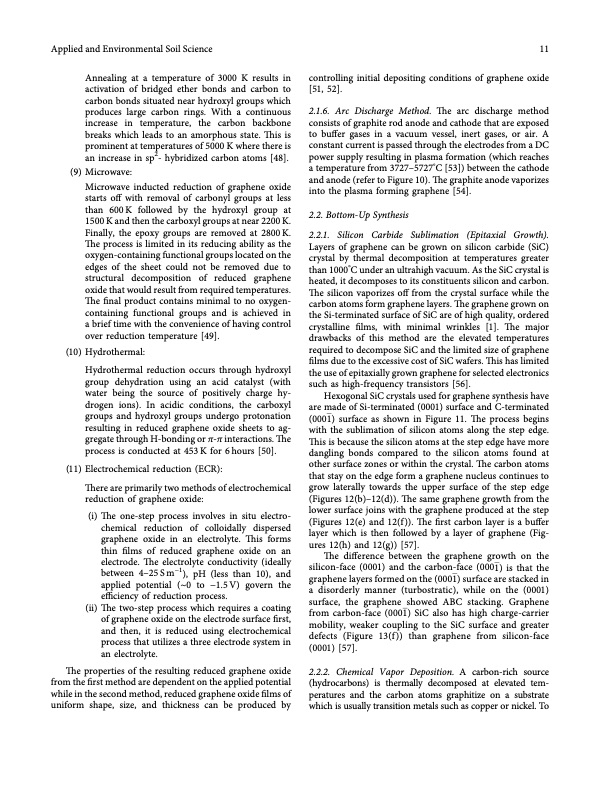PDF Publication Title:
Text from PDF Page: 011
Applied and Environmental Soil Science 11 Annealing at a temperature of 3000 K results in activation of bridged ether bonds and carbon to carbon bonds situated near hydroxyl groups which produces large carbon rings. With a continuous increase in temperature, the carbon backbone breaks which leads to an amorphous state. Tis is prominent at temperatures of 5000 K where there is an increase in sp2- hybridized carbon atoms [48]. (9) Microwave: Microwave inducted reduction of graphene oxide starts of with removal of carbonyl groups at less than 600K followed by the hydroxyl group at 1500 K and then the carboxyl groups at near 2200 K. Finally, the epoxy groups are removed at 2800 K. Te process is limited in its reducing ability as the oxygen-containing functional groups located on the edges of the sheet could not be removed due to structural decomposition of reduced graphene oxide that would result from required temperatures. Te fnal product contains minimal to no oxygen- containing functional groups and is achieved in a brief time with the convenience of having control over reduction temperature [49]. (10) Hydrothermal: Hydrothermal reduction occurs through hydroxyl group dehydration using an acid catalyst (with water being the source of positively charge hy- drogen ions). In acidic conditions, the carboxyl groups and hydroxyl groups undergo protonation resulting in reduced graphene oxide sheets to ag- gregate through H-bonding or π-π interactions. Te process is conducted at 453 K for 6 hours [50]. (11) Electrochemical reduction (ECR): Tere are primarily two methods of electrochemical reduction of graphene oxide: (i) Te one-step process involves in situ electro- chemical reduction of colloidally dispersed graphene oxide in an electrolyte. Tis forms thin flms of reduced graphene oxide on an electrode. Te electrolyte conductivity (ideally between 4–25Sm−1), pH (less than 10), and applied potential (∼0 to −1.5V) govern the efciency of reduction process. (ii) Te two-step process which requires a coating of graphene oxide on the electrode surface frst, and then, it is reduced using electrochemical process that utilizes a three electrode system in an electrolyte. Te properties of the resulting reduced graphene oxide from the frst method are dependent on the applied potential while in the second method, reduced graphene oxide flms of uniform shape, size, and thickness can be produced by controlling initial depositing conditions of graphene oxide [51, 52]. 2.1.6. Arc Discharge Method. Te arc discharge method consists of graphite rod anode and cathode that are exposed to bufer gases in a vacuum vessel, inert gases, or air. A constant current is passed through the electrodes from a DC power supply resulting in plasma formation (which reaches a temperature from 3727–5727°C [53]) between the cathode and anode (refer to Figure 10). Te graphite anode vaporizes into the plasma forming graphene [54]. 2.2. Bottom-Up Synthesis 2.2.1. Silicon Carbide Sublimation (Epitaxial Growth). Layers of graphene can be grown on silicon carbide (SiC) crystal by thermal decomposition at temperatures greater than 1000°C under an ultrahigh vacuum. As the SiC crystal is heated, it decomposes to its constituents silicon and carbon. Te silicon vaporizes of from the crystal surface while the carbon atoms form graphene layers. Te graphene grown on the Si-terminated surface of SiC are of high quality, ordered crystalline flms, with minimal wrinkles [1]. Te major drawbacks of this method are the elevated temperatures required to decompose SiC and the limited size of graphene flms due to the excessive cost of SiC wafers. Tis has limited the use of epitaxially grown graphene for selected electronics such as high-frequency transistors [56]. Hexogonal SiC crystals used for graphene synthesis have are made of Si-terminated (0001) surface and C-terminated (0001) surface as shown in Figure 11. Te process begins with the sublimation of silicon atoms along the step edge. Tis is because the silicon atoms at the step edge have more dangling bonds compared to the silicon atoms found at other surface zones or within the crystal. Te carbon atoms that stay on the edge form a graphene nucleus continues to grow laterally towards the upper surface of the step edge (Figures 12(b)–12(d)). Te same graphene growth from the lower surface joins with the graphene produced at the step (Figures 12(e) and 12(f)). Te frst carbon layer is a bufer layer which is then followed by a layer of graphene (Fig- ures 12(h) and 12(g)) [57]. Te diference between the graphene growth on the silicon-face (0001) and the carbon-face (0001) is that the graphene layers formed on the (0001) surface are stacked in a disorderly manner (turbostratic), while on the (0001) surface, the graphene showed ABC stacking. Graphene from carbon-face (0001) SiC also has high charge-carrier mobility, weaker coupling to the SiC surface and greater defects (Figure 13(f)) than graphene from silicon-face (0001) [57]. 2.2.2. Chemical Vapor Deposition. A carbon-rich source (hydrocarbons) is thermally decomposed at elevated tem- peratures and the carbon atoms graphitize on a substrate which is usually transition metals such as copper or nickel. ToPDF Image | State-of-the-Art Graphene Synthesis Methods

PDF Search Title:
State-of-the-Art Graphene Synthesis MethodsOriginal File Name Searched:
8475504.pdfDIY PDF Search: Google It | Yahoo | Bing
Salgenx Redox Flow Battery Technology: Power up your energy storage game with Salgenx Salt Water Battery. With its advanced technology, the flow battery provides reliable, scalable, and sustainable energy storage for utility-scale projects. Upgrade to a Salgenx flow battery today and take control of your energy future.
CONTACT TEL: 608-238-6001 Email: greg@infinityturbine.com (Standard Web Page)